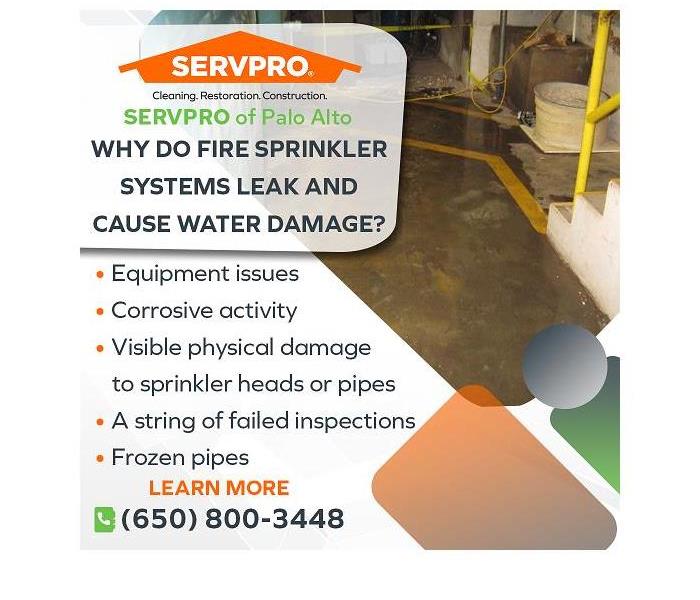Fire sprinkler malfunctions: Five common causes and how to address the resulting water damage
2/14/2023 (Permalink)
Blog Summary: SERVPRO of Palo Alto explains how fire sprinkler systems can malfunction, causing serious water damage in a commercial setting.
SERVPRO® of Palo Alto is a local leader in property damage cleanup and restoration, including water removal, dehumidification, disinfection, and deodorizing. These services are vital when a fire sprinkler system leaks or accidentally activates, flooding an office space, retail unit, or manufacturing facility with foul-smelling, stagnant water.
The discovery and diagnosis of an issue with the fire sprinkler system largely depend on the presence or absence of water dripping from a sprinkler head. The small, almost imperceptible leak may be the only clue the system has an issue or is about to experience a catastrophic failure. Even the tiniest leak calls for immediate attention. Otherwise, the consequences, an unintentional activation of the sprinkler system, would be disastrous.
These warning signs indicate the need to have the fire sprinkler system inspected by a professional well acquainted with the maintenance and repair of a fire sprinkler system.
1. Equipment issues
A leak left unrepaired can lead to the failure of the fire protection equipment. A leak in a dry system will cause the compressor to run continuously in an effort to keep water out of the pipes. The compressor will eventually overheat if the leak is not discovered and repaired. The system can activate without provocation if the situation persists.
2. Corrosive activity
Another warning sign of a current or impending leak is corrosion. According to fire safety experts, “Microbiologically influenced corrosion was thought to be the primary cause of fire sprinkler corrosion for many years. But the real culprit is oxygen. If you come across a rotten egg smell, discolored water, rusting, or an obstruction, then corrosion may have caused the leak.”
Begin the search for a possible leak. If a leak is discovered, make an appointment for a professional to conduct an on-site inspection and assessment of the fire protection system. Eliminating the existing corrosion and resolving the water leak will extend the life of the system and keep the facility safe under the umbrella of the sprinkler system’s protection.
3. Visible physical damage to sprinkler heads or pipes
Regular inspections and casual observations should take note not only of apparent leaks, stagnant odors, and discoloration but also of visible physical damage to the system. Custodial staff and service crews may damage sprinkler heads while cleaning the facility or repairing other damage. An impact from a scissor lift or a forklift can also compromise the integrity of the fire protection system. Damaged sprinklers, crooked or crimped pipes, and leaks along joints and fittings need immediate attention. A fire protection system is built to withstand some measure of punishment in the work environment, but this does not mean the system is indestructible. A fire sprinkler system may be finicky to maintain at times. However, if the system fails when a fire breaks out, a manufacturing facility of several hundred thousand square feet can become engulfed in flames in minutes, not hours. The fire sprinkler system should be respected and protected for its lifesaving capabilities.
4. A string of failed inspections
Fire protection systems are typically required to undergo annual inspections. The inspections are intended to identify leaks, corrosion, and damage to sprinkler heads and pipes. Deficiencies should be quickly repaired, and timely upgrades and replacements will keep the system ready in case of fire. The inspections also instill confidence in the system's integrity to function properly. A string of failed inspections without the needed performance of repairs and maintenance will allow for issues to compound over time. The only incident worse than an unintended activation is a failed activation in the event of a fire.
5. Frozen pipes
Ice is the enemy of the wet pipe fire protection system. A facility with a wet pipe system should maintain temperatures at or above 40 degrees Fahrenheit to prevent water in the pipes from freezing. Frozen water expands. The dynamic force of ice can rupture pipes, crack housings, and damage pipe joints. If the system freezes, the damage to the pipes and sprinkler heads could be catastrophic. If the system thaws when the facility is closed for the weekend, Monday morning could surprise the person tasked with opening the facility. It is imperative to keep the facility warm enough to prevent freezing. Close any windows, doors, or shipping bays that might allow heat to escape and cold air to enter. The solution for areas of the facility where temperatures regularly dip below freezing is installing a dry pipe fire protection system.
How to handle leaks or an accidental activation
An accidental activation can flood a professional office, retail space, or manufacturing unit with hundreds of gallons of water in just minutes. When circumstances demand a rapid response and a quick cleanup and restoration project, turn to a property damage cleanup and restoration leader, SERVPRO of Palo Alto. Utilizing powerful wet/dry vacuums and dehumidifiers, the team of IICRC-certified technicians can remove the water, dry out the remaining moisture, and get the facility up and running very quickly. Available 24/7, 365 days a year, including holidays, the SERVPRO team can be on-site in about an hour to begin the water damage cleanup project. SERVPRO can also handle the insurance claims process from end to end.
To learn more about water removal services in Old Mountain View, Mountain View, CA, and nearby areas, call SERVPRO of Palo Alto at (650) 800-3448. The office can also be contacted by emailing office@SERVPROpaloalto.com.



 24/7 Emergency Service
24/7 Emergency Service
